Plesiopleurodon
Plesiopleurodon (/ˌpliːsiəˈplʊərədɒn/; Greek: plesios, meaning “near to”, pleuro, meaning “side”, and don, meaning “tooth”) is an extinct genus of Mesozoic marine reptiles, belonging to Sauropterygia, known from the Late Cretaceous of North America. It was named by Kenneth Carpenter based on a complete skull with a mandible, cervical vertebra, and a coracoid.[3] In naming the specimen, Carpenter noted "Of all known pliosaurs, Plesiopleurodon wellesi most closely resembles Liopleurodon ferox from the Oxfordian of Europe, hence the generic reference."[3] It was initially described as a pliosaur due to it short neck, a common trait of the family, although it is in the order Plesiosauria.[3][4][5] However, later exploration into the relationships of both orders indicate that not all pliosaurs have short necks and not all plesiosaurs have long necks.[3]
| Plesiopleurodon | |
|---|---|
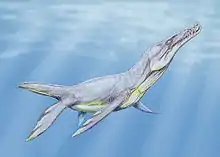 | |
| Restoration | |
| Scientific classification | |
| Kingdom: | |
| Phylum: | |
| Class: | |
| Superorder: | |
| Order: | |
| Suborder: | |
| Family: | |
| Genus: | †Plesiopleurodon Carpenter, 1996 [2] |
| Species | |
| |
It is distinguishable by its short neck, elongated head, and comparatively few teeth in the symphysis when compared to other plesiosaurs.[3][6]
History of discovery
The holotype was collected from the Belle Fourche Shale in the Rattlesnake Hills of Wyoming (lower Cenomanian).[3] It is the only known fossil of Plesiopleurodon.[3][7]
Description
Skull and dentition
The skull is 71.2 cm long.[3] The roof was slightly crushed and a parietal is damaged, but is otherwise in good condition. The premaxilla forms the dorsal edge of the external naris, like Pliosaurus and Rhomaleosaurus.[3][8] In Liopleurodon ferox, the premaxilla does not share this connection.[3] Like L. ferox, the premaxillaries separate the frontals.[3] The temporal fenestra is longer than it is wide.[3] It retains the primitive plesiosaur feature of posterior sloping of the skull.[3] The quadrate is firmly attached, unlike the attachments seen in most polycotylids.[3] The orbit has a reniform, or kidney-like, shape caused by posterior extension of the maxilla toward the prefrontals.[8] The pre-orbital skull length ratio is high, indicating a longer snout than other polycotylids.[7] The postorbital bar is reduced.[8]
The dentary has many ridges and valleys, becoming especially prominent near the enlarged caniniform teeth.[3][9] The tooth margin alternates between concave and convex on the dentary.[3] 19 teeth are in the dentaries, but there may be more that are not visible due to presence of the matrix it was mostly uncovered from.[3] The eight caniniform teeth are procumbent, or tilt forward, and smooth but are striated near where they attach to the jaw.[3][8] The skull was not prepared in such a way that allows for examination of the palate.[6]
Postcrania
The cervical vertebrae are slightly wider than long and have equal lengths and heights.[3] Like other Cretaceous pliosaurs, the cervical ribs have one head.[3]
The coracoid has a long interpectoral bar that is longer than any seen in Jurassic pliosaurs.[3]
Classification
There is ongoing debate about where Plesiopleurdon wellesi phylogenetically fits within Sauropsida, with arguments placing it as a pliosaurid, non-plesiosaurid, and polycotylid.[5][8] Placement as a pliosaurid or polycotylid agrees that the taxon is a plesiosaurid, but diverged at different times. Current consensus places Plesiopleurodon as a polycotylid.[8][7]
Some paleontologists proposed the formation of a grade called Occultonectia clade nov that would include Plesiopleurodon, the 'Richmond pliosaur' (museum number QM F18041), and Sulcusuchus erraini based on their prior interpretations as non-polycotylids.[8]
Paleobiogeography
The earliest plesiosaurs are solely found in the Northern hemisphere but diversified in the Jurassic.[10] By the Early Jurassic, they are regarded as cosmopolitan and are primarily known from the Tethys Realm of Europe and China.[10] This widespread distribution coincides with a global sea level rise and the breakup of Pangaea, allowing for marine corridors to be used for dispersal.[10]
Plesiopleurodon, like all plesiosaurs, are obligatory aquatic animals that rely on paraxial propulsion to swim.[10] This means locomotion depends on the propulsion from paddle-like flippers, much like how sea turtles move.[10]
Geographic and stratigraphic range
The Belle Fourche Shale of northeastern Wyoming has about 400 to 800 feet of noncalcareous shale between the siliceous Mowry Shale below and the calcareous Greenhorn Formation above.[11] It contains large ironstone concretions in the lower 50 feet of the formation.[11] Bentonite beds are present throughout the shale.[11] Of the shale that extends into Alberta, the formation primarily consists of shale, siltstone, and sandstone.[12] The sandstones in southeastern Alberta and southwestern Saskatchewan are shallow gas reservoirs.[12]
While the Belle Fourche Shale is dated to the Cenomian, most of the fossils discovered there are from the uppermost portion, more than 500 feet above the base of the formation.[11] The primary fossils found include many species of ammonites and foraminifera, with few significant macrofossils.[11]
See also
References
- Ketchum, H.F.; Benson, R.B.J. (2010). "Global interrelationships of Plesiosauria (Reptilia, Sauropterygia) and the pivotal role of taxon sampling in determining the outcome of phylogenetic analyses". Biological Reviews of the Cambridge Philosophical Society. 85 (2): 361–392. doi:10.1111/j.1469-185X.2009.00107.x. PMID 20002391.
- Carpenter K. 1996. A review of short-necked plesiosaurs from the Cretaceous of the Western Interior, North America. Neues Jahrbuch für Geologie und Paläontologie, Abhandlungen 210 (2): 259-287.
- Carpenter, Kenneth (1996-09-27). "A review of short-necked plesiosaurs from the Cretaceous of the Western Interior, North America". Neues Jahrbuch für Geologie und Paläontologie - Abhandlungen. 201 (2): 259–287. doi:10.1127/njgpa/201/1996/259. ISSN 0077-7749.
- Druckenmiller, Patrick; Knutsen, Espen (2012-01-01). "Phylogenetic relationships of Upper Jurassic (Middle Volgian) plesiosaurians (Reptilia: Sauropterygia) from the Agardhfjellet Formation of central Spitsbergen, Norway". Norsk Geologisk Tidsskrift. 92: 277–284.
- Benson, Roger B. J.; Druckenmiller, Patrick S. (2014). "Faunal turnover of marine tetrapods during the Jurassic–Cretaceous transition". Biological Reviews. 89 (1): 1–23. doi:10.1111/brv.12038. ISSN 1469-185X. PMID 23581455.
- Schumacher, Bruce A. (September 2008). "On the skull of a pliosaur (Plesiosauria; Pliosauridae) from the Upper Cretaceous (Early Turonian) of the North American Western Interior". Transactions of the Kansas Academy of Science. 111 (3): 203–218. doi:10.1660/0022-8443-111.3.203. ISSN 0022-8443. S2CID 86751839.
- Ketchum, Hilary F.; Benson, Roger B. J. (2010). "Global interrelationships of Plesiosauria (Reptilia, Sauropterygia) and the pivotal role of taxon sampling in determining the outcome of phylogenetic analyses". Biological Reviews. 85 (2): 361–392. doi:10.1111/j.1469-185X.2009.00107.x. ISSN 1469-185X. PMID 20002391.
- Fischer, V.; Benson, R. B. J.; Druckenmiller, P. S.; Ketchum, H. F.; Bardet, N. (2018). "The evolutionary history of polycotylid plesiosaurians". Royal Society Open Science. 5 (3): 172177. doi:10.1098/rsos.172177. PMC 5882735. PMID 29657811.
- Druckenmiller, Pat S. (2002-03-14). "Osteology of a new plesiosaur from the lower Cretaceous (Albian) Thermopolis Shale of Montana". Journal of Vertebrate Paleontology. 22 (1): 29–42. doi:10.1671/0272-4634(2002)022[0029:OOANPF]2.0.CO;2. ISSN 0272-4634.
- Bardet, N.; Falconnet, J.; Fischer, V.; Houssaye, A.; Jouve, S.; Pereda Suberbiola, X.; Pérez-García, A.; Rage, J. -C.; Vincent, P. (2014-11-01). "Mesozoic marine reptile palaeobiogeography in response to drifting plates" (PDF). Gondwana Research. 26 (3): 869–887. doi:10.1016/j.gr.2014.05.005. ISSN 1342-937X.
- Eicher, Don L. (1967). "Foraminifera from Belle Fourche Shale and Equivalents, Wyoming and Montana". Journal of Paleontology. 41 (1): 167–188. ISSN 0022-3360. JSTOR 1301912.
- Yang, Yongtai; Miall, Andrew D. (2010-05-01). "Migration and stratigraphic fill of an underfilled foreland basin: Middle–Late Cenomanian Belle Fourche Formation in southern Alberta, Canada". Sedimentary Geology. 227 (1): 51–64. doi:10.1016/j.sedgeo.2010.03.005. ISSN 0037-0738.
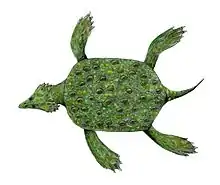

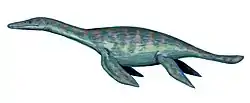

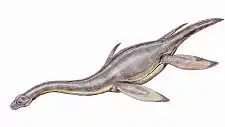
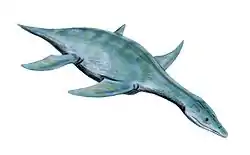
.png.webp)
